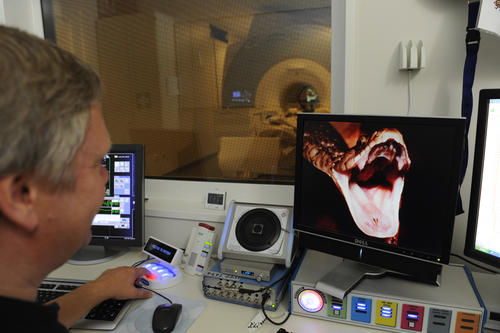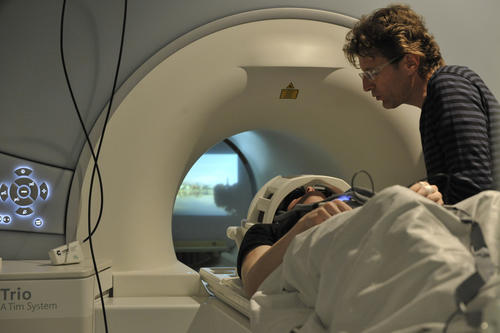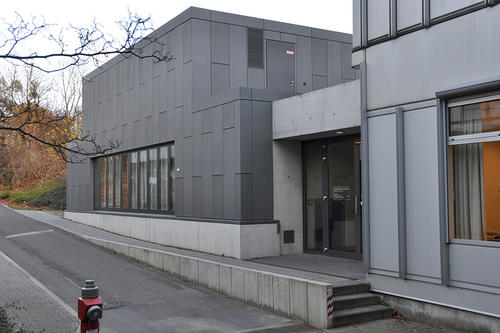It’s All in Your Head
The Center for Cognitive Neuroscience Berlin at Freie Universität offers a unique infrastructure for interdisciplinary brain research.
Dec 10, 2015
During an experiment, a test subject sees stimuli while undergoing an MRI scan – here, a picture of a snake. The investigator can keep track of the material that is being displayed and what is going on in the scanner room via monitors.
Image Credit: Bernd Wannenmacher
A test subject is moved into the “tube” of the MRI unit. The functional images of his brain will later be analyzed using statistical methods.
Image Credit: Bernd Wannenmacher
Because of its size, the MRI unit had to be hoisted up and lowered into the new building through the roof in 2009.
Image Credit: Bernd Wannenmacher
Some of the CCNB’s labs are located in this building at the end of the Silberlaube complex.
Image Credit: Nina Diezemann
What role do feelings play when we make decisions? Why do the Harry Potter novels carry us off into faraway worlds? Can people perceive a rubber hand as part of their own body?
These are just a few of the many questions the researchers at the Center for Cognitive Neuroscience Berlin (CCNB) are trying to answer. At their labs at Freie Universität, they can combine various imaging methods, such as magnetic resonance imaging (MRI) and electroencephalography (EEG), which makes it possible to watch the brain during the processes of thinking and feeling.
Tucked away in a nondescript gray building annex between the Silberlaube and the neighboring villa gardens, not far from Fabeck Strasse, is a huge device that is so heavy, with such imposing dimensions, that it had to be hoisted up by crane and then lowered into the building through an opening in the roof.
In 2009, the university used funding from the “Languages of Emotion” cluster of excellence to purchase a functional MRI scanner, a measuring system that uses an ultra-strong magnet to generate high-resolution images of how the blood circulation in the various areas of the brain changes during the processes of thinking and feeling, providing precise information on brain activity. During the tests, the test subject lies in a tube. The functional images of his or her brain are recorded continuously and then analyzed using complex statistical methods.
CCNB Continues the Research of “Languages of Emotion”
“Languages of Emotion,” a research alliance funded by the Excellence Initiative of the German federal and state governments that studied the relationships between emotions, language, culture, and society, concluded its work in 2014. The Center for Cognitive Neuroscience Berlin (CCNB) is now continuing and advancing the earlier group’s neuroscience research.
The center, which is part of the Department of Education and Psychology, is a place where scientists from a wide range of different disciplines can perform their experiments – and network with others on an interdisciplinary basis. In addition to the MRI system, the center offers various labs with a wide range of available methods, including EEG and near-infrared spectroscopy, two other methods of measuring brain activity; eye tracking, which allows researchers to track test subjects’ eye movements; and transcranial magnetic stimulation, a method that can be used to stimulate superficial areas of the brain, triggering or impeding certain processes.
An Educational Advantage for Students
These labs are of a kind found nowhere else in university psychological research in Germany, says Arthur Jacobs, a professor at the Experimental and Neurocognitive Psychology division at Freie Universität. Jacobs is one of the CCNB’s two scientific directors, and it is largely due to his efforts that Freie Universität has this kind of lab today.
Jacobs, whose areas of emphasis include research on reading, was appointed to teach at Freie Universität in 2003. At that point, he had proposed a number of things to the university management, a new lab concept among them. “The labs were not supposed to be headed by one professor, but instead be available for general use,” he says, adding, “The idea was for everyone who uses modern neurocognitive methods – such as imaging technology – in studies to be able to do research there.”
On top of that, junior scientists and researchers can gain initial experience with these methods. While working with equipment like this used to be restricted to scientists and researchers, students of psychology at Freie Universität can now also familiarize themselves with data acquisition, analysis, and interpretation during a research internship. Jacobs views research-oriented teaching as one of the CCNB’s main tasks, pointing out that students enrolled in both bachelor’s and master’s degree programs use the labs. “That gives our students an important educational advantage,” Jacobs says.
Interlinking Disciplines and Institutions
Hauke Heekeren, a professor of biological psychology and cognitive neuroscience and the managing director of the CCNB, believes one of the center’s main advantages is that it is part of a university, so researchers from other departments can also use the infrastructure. Alongside psychologists and medical researchers, others from fields such as sociology, economics, education, linguistics, and sports also gain insight into the human brain here.
There are already cooperative initiatives in place with institutions outside the university, such as the German Center for Neurodegenerative Diseases (DZNE). With this in mind, the CCNB consists of both a core team and a number of other researchers from Freie Universität, Humboldt-Universität zu Berlin, Technische Universität Berlin, and Charité – Universitätsmedizin Berlin, the joint medical school of Freie Universität and Humboldt-Universität zu Berlin.
The core team comprises Dirk Ostwald, a junior professor of computational cognitive neuroscience; Peter Mohr, a junior professor and head of the Neuroeconomics junior research group jointly funded by Freie Universität and the Berlin Social Science Center (WZB); and Malek Bajbouj, a professor of affective neuroscience at Freie Universität and Charité.
“Joint research projects are important for us,” says Heekeren. “For example, we are working with colleagues from other universities in Berlin, Charité, the Max Planck Institute for Human Development, and the Berlin Social Science Center (WZB) to identify basic principles of decision making. We want to clarify how they are affected by individual and social factors, and what kinds of changes there are in those with psychiatric disorders.”
Body Awareness and Philosophy
Felix Blankenburg is a professor of neurocomputation and neuroimaging at Freie Universität and, like Jacobs, a scientific director of the CCNB. Blankenburg is responsible for the MRI lab and for transcranial magnetic stimulation. He describes how the experiments conducted in the scanner can have an impact that reaches all the way to other disciplines, such as philosophy. “During research on body image, for example, a rubber hand and the test subject’s hand are touched at the same time, but all the subject sees is the rubber hand. Now the subject associates the visual perception with the actual touch, perceiving the rubber hand as part of his or her own body.”
Blankenburg and his team study which areas of the brain are involved in this perception. “When it comes to body image, there are large areas of overlap with philosophy,” Blankenburg says. “In the philosophy of mind, for example, a philosophical approach that focuses on human thinking, one important question is how models of the self emerge.”
All of this means that the CCNB offers a stimulating research environment, especially for those who are doing research as part of interdisciplinary projects or are planning these kinds of projects. Another factor contributing to this is a colloquium featuring talks and project introductions. This semester marks the second time that the colloquium has been offered.
Further Information
- Homepage of the CCNB
- Every second and fourth Monday during the semester, the CCNB Seminar takes place. Interested persons may subscribe to the email list. The next seminar will be on December 14, 2015.




